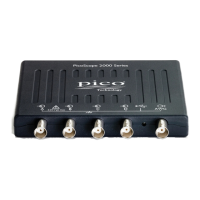API Functions
41Copyright © 2006–2022 Pico Technology Ltd. All rights reserved.ps2000pg.en-12
PicoScope 2000 Series Programmer's Guide
5.20.1 PS2000_TRIGGER_CONDITIONS structure
A structure of this type is passed to ps2000SetAdvTriggerChannelConditions in the
conditions argument to specify the trigger conditions, and is defined as follows:
typedef struct tPS2000TriggerConditions
{
PS2000_TRIGGER_STATE channelA;
PS2000_TRIGGER_STATE channelB;
PS2000_TRIGGER_STATE channelC;
PS2000_TRIGGER_STATE channelD;
PS2000_TRIGGER_STATE external;
PS2000_TRIGGER_STATE pulseWidthQualifier;
} PS2000_TRIGGER_CONDITIONS;
See ps2000SetAdvTriggerChannelConditions
channelA, channelB: the type of condition that should be applied to
each channel. Use these constants:
CONDITION_DONT_CARE (0)
CONDITION_TRUE (1)
CONDITION_FALSE (2)
channelC, channelD: not used
external: not used
pulseWidthQualifier: the type of condition to apply to the pulse width
qualifier. Choose from the same list of constants given under channelA,
channelB.
Remarks
The channels that are set to CONDITION_TRUE or CONDITION_FALSE must all meet their
conditions simultaneously to produce a trigger. Channels set to CONDITION_DONT_CARE are
ignored.
The PicoScope 2202 oscilloscope can use only a single input channel (either channel A or
channel B) for the trigger source. Therefore you may define CONDITION_TRUE or
CONDITION_FALSE for only one of these channels at a time. You can, optionally, set up the
pulse width qualifier in combination with one of the input channels.
The PicoScope 2204, 2204A, 2205 and 2205A models can all trigger from both channel A and
channel B, and therefore all support logic triggering.

